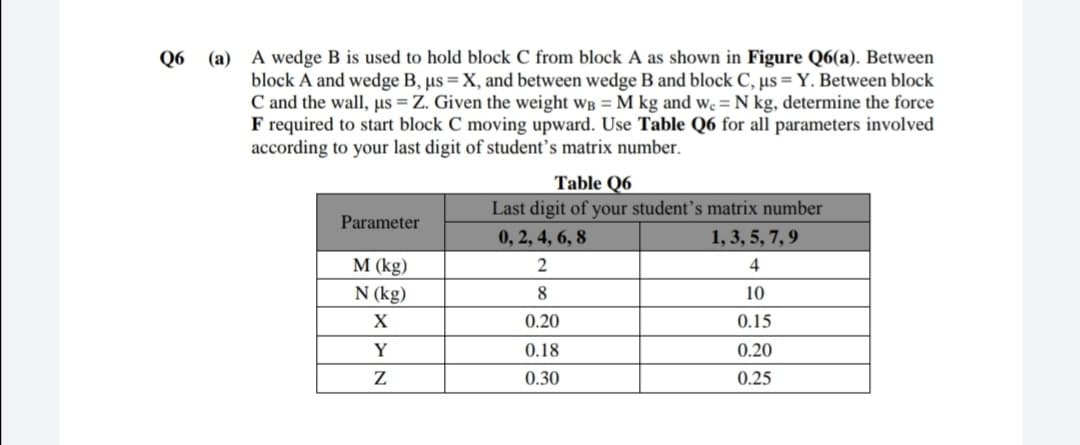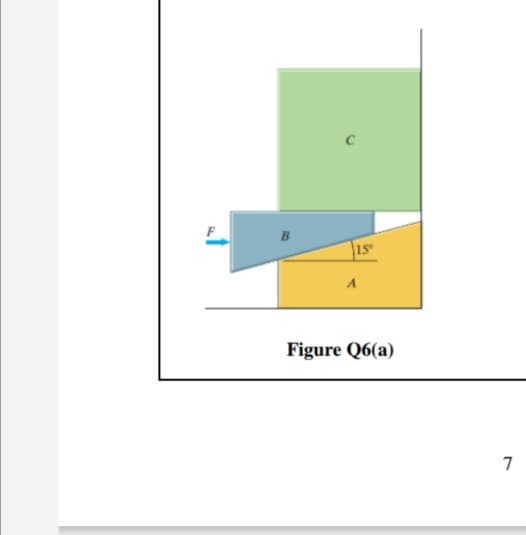(a) A wedge B is used to hold block C from block A as shown in Figure Q6(a). Between block A and wedge B, µs=X, and between wedge B and block C, µs = Y. Between block C and the wall, µs = Z. Given the weight wB = M kg and we = N kg, determine the force F required to start block C moving upward. Use Table Q6 for all parameters involved according to your last digit of student's matrix number. Q6 Table Q6 Last digit of your student's matrix number Parameter 0, 2, 4, 6, 8 1,3, 5, 7, 9 M (kg) N (kg) 2 4 8 10 X 0.20 0.15 Y 0.18 0.20 0.30 0.25
(a) A wedge B is used to hold block C from block A as shown in Figure Q6(a). Between block A and wedge B, µs=X, and between wedge B and block C, µs = Y. Between block C and the wall, µs = Z. Given the weight wB = M kg and we = N kg, determine the force F required to start block C moving upward. Use Table Q6 for all parameters involved according to your last digit of student's matrix number. Q6 Table Q6 Last digit of your student's matrix number Parameter 0, 2, 4, 6, 8 1,3, 5, 7, 9 M (kg) N (kg) 2 4 8 10 X 0.20 0.15 Y 0.18 0.20 0.30 0.25
Principles of Physics: A Calculus-Based Text
5th Edition
ISBN:9781133104261
Author:Raymond A. Serway, John W. Jewett
Publisher:Raymond A. Serway, John W. Jewett
Chapter5: More Applications Of Newton’s Laws
Section: Chapter Questions
Problem 14P: Three objects are connected on a table as shown in Figure P5.14. The coefficient of kinetic friction...
Related questions
Question
Last digit is =0

Transcribed Image Text:Q6 (a) A wedge B is used to hold block C from block A as shown in Figure Q6(a). Between
block A and wedge B, µs =X, and between wedge B and block C, µs = Y. Between block
C and the wall, µs = Z. Given the weight wg = M kg and we = N kg, determine the force
F required to start block C moving upward. Use Table Q6 for all parameters involved
according to your last digit of student's matrix number.
Table Q6
Last digit of your student's matrix number
Parameter
0, 2, 4, 6, 8
1, 3, 5, 7, 9
M (kg)
2
4
N (kg)
8
10
X
0.20
0.15
Y
0.18
0.20
0.30
0.25

Transcribed Image Text:15
Figure Q6(a)
7
Expert Solution
This question has been solved!
Explore an expertly crafted, step-by-step solution for a thorough understanding of key concepts.
Step by step
Solved in 2 steps with 1 images

Knowledge Booster
Learn more about
Need a deep-dive on the concept behind this application? Look no further. Learn more about this topic, physics and related others by exploring similar questions and additional content below.Recommended textbooks for you

Principles of Physics: A Calculus-Based Text
Physics
ISBN:
9781133104261
Author:
Raymond A. Serway, John W. Jewett
Publisher:
Cengage Learning

Physics for Scientists and Engineers with Modern …
Physics
ISBN:
9781337553292
Author:
Raymond A. Serway, John W. Jewett
Publisher:
Cengage Learning

Physics for Scientists and Engineers
Physics
ISBN:
9781337553278
Author:
Raymond A. Serway, John W. Jewett
Publisher:
Cengage Learning

Principles of Physics: A Calculus-Based Text
Physics
ISBN:
9781133104261
Author:
Raymond A. Serway, John W. Jewett
Publisher:
Cengage Learning

Physics for Scientists and Engineers with Modern …
Physics
ISBN:
9781337553292
Author:
Raymond A. Serway, John W. Jewett
Publisher:
Cengage Learning

Physics for Scientists and Engineers
Physics
ISBN:
9781337553278
Author:
Raymond A. Serway, John W. Jewett
Publisher:
Cengage Learning

College Physics
Physics
ISBN:
9781938168000
Author:
Paul Peter Urone, Roger Hinrichs
Publisher:
OpenStax College

College Physics
Physics
ISBN:
9781285737027
Author:
Raymond A. Serway, Chris Vuille
Publisher:
Cengage Learning

Physics for Scientists and Engineers, Technology …
Physics
ISBN:
9781305116399
Author:
Raymond A. Serway, John W. Jewett
Publisher:
Cengage Learning